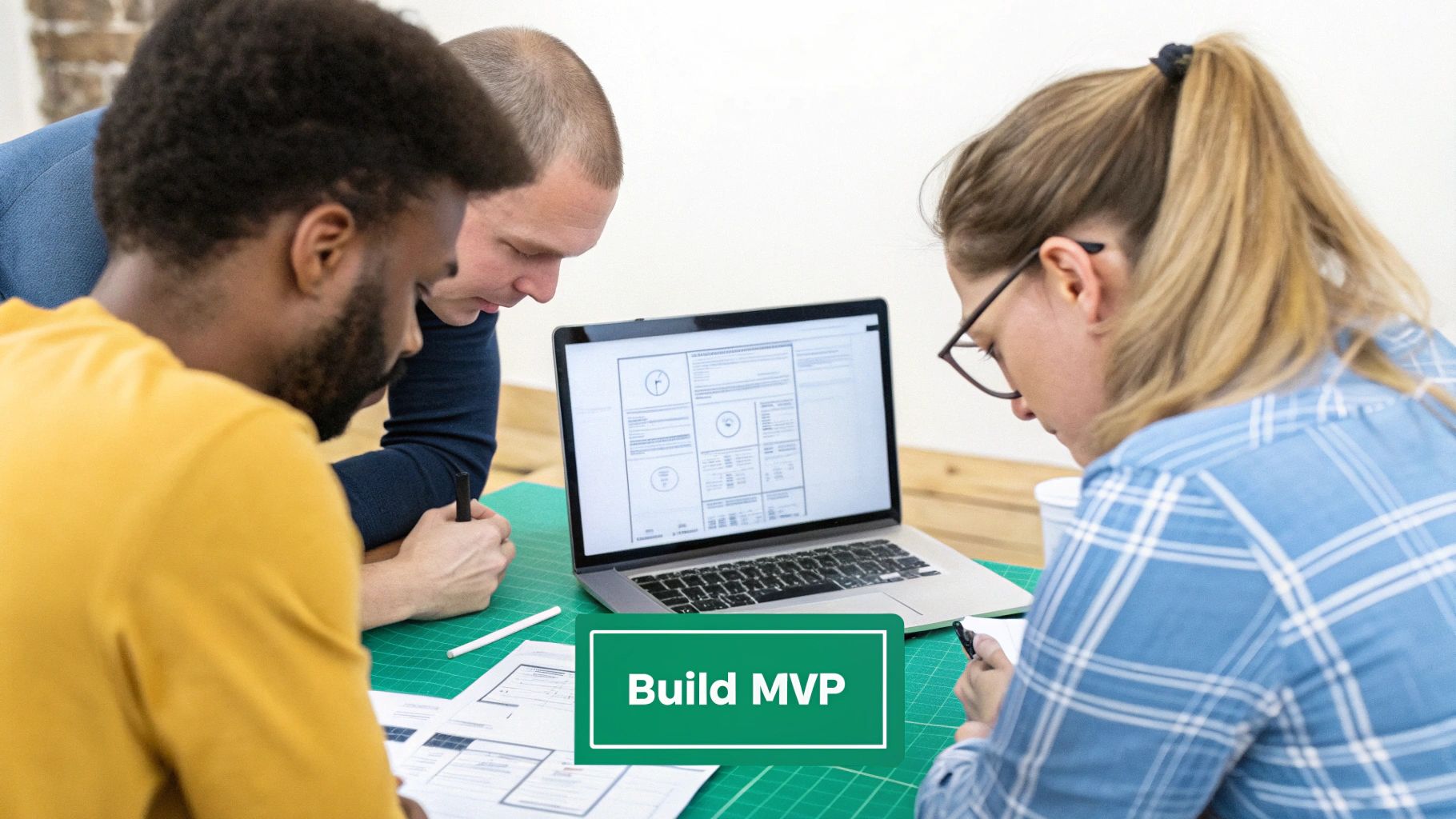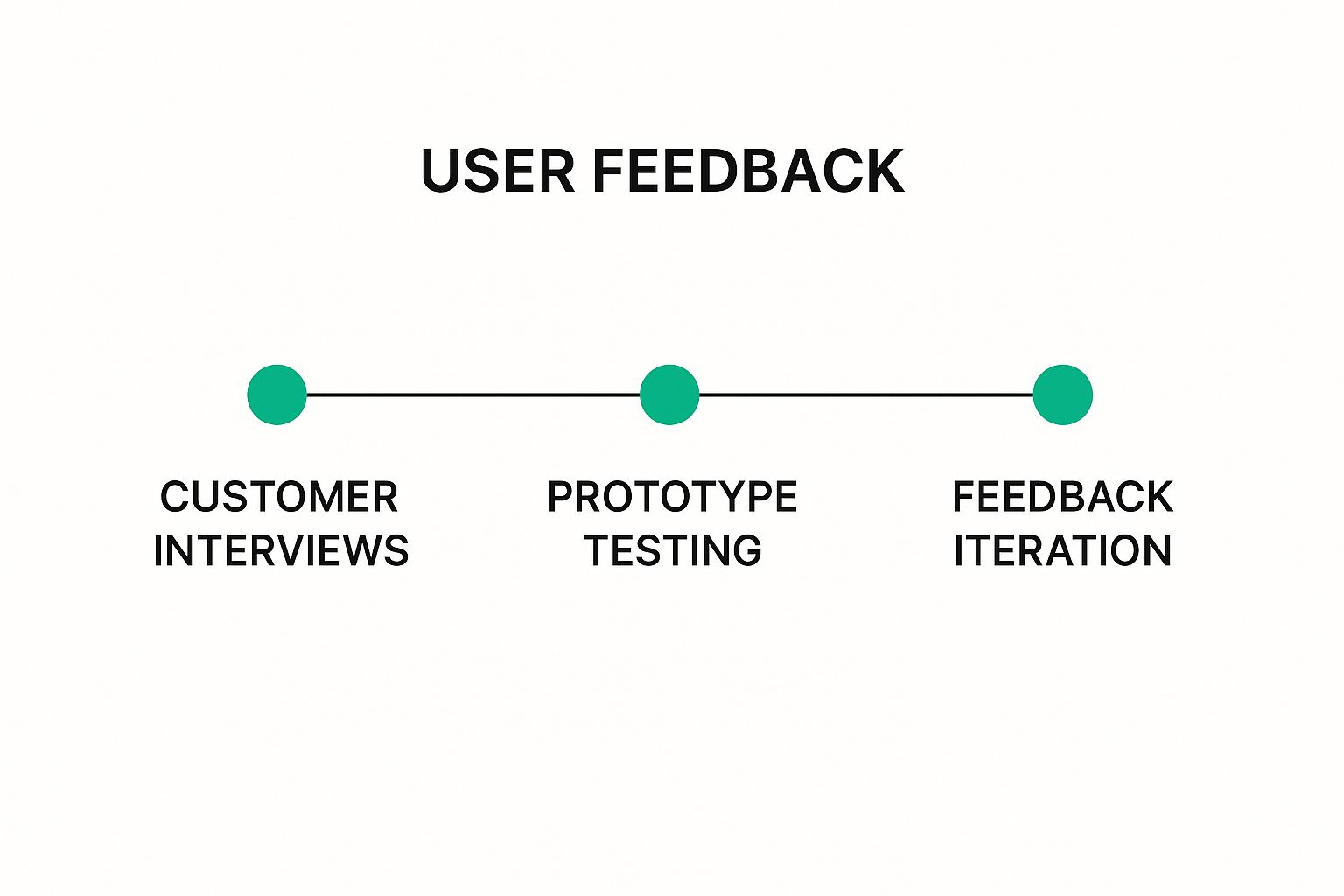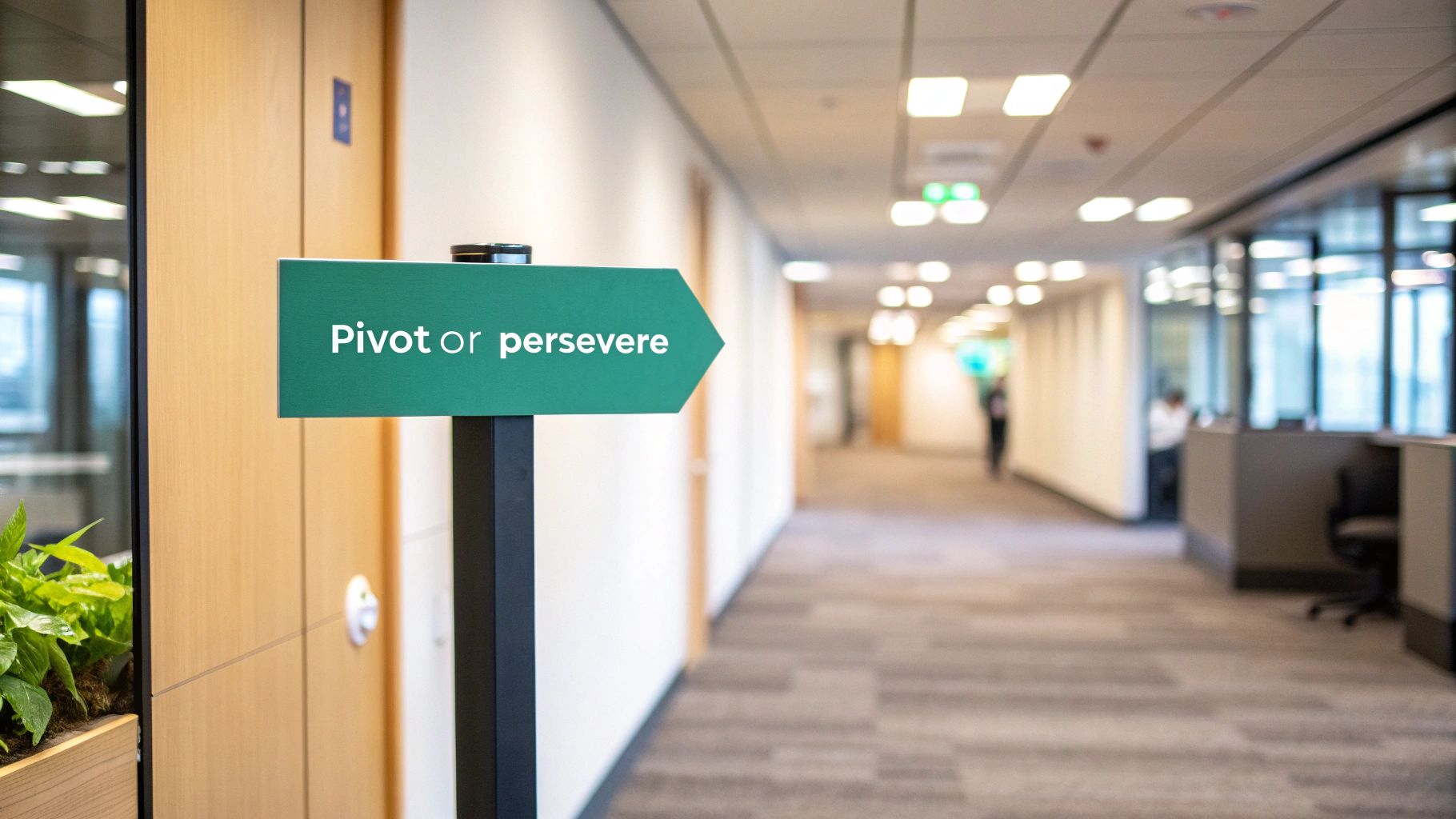Why Most Startup Ideas Fail Before They Start

The entrepreneurial journey is often seen through rose-tinted glasses. But the truth is, launching a startup is tough. Many promising ventures never even launch. Understanding why is the first step towards building a sustainable business. This isn't about being negative, it's about being realistic and giving yourself the knowledge to succeed. This begins with understanding how to validate your startup idea.
The Harsh Reality of Startup Failure Rates
The startup world is a tough place, and many don't survive. A key statistic in validating a startup idea lies in the failure rates. Data from 2025 shows that up to 90% of startups fail, with 10% failing in the first year. Between years two and five, another 70% fail.
This data highlights that most startups don't make it past the initial years. This underscores the importance of thorough idea validation before investing heavily. Common reasons for failure are a lack of product-market fit (34%) and poor marketing strategies (22%). Having a great idea isn't enough; you need to make sure there's a market for it. For more information on these statistics, check out this resource: Startup Failure Stats.
Separating Survivors From Statistics
What separates the thriving startups from the failures? Successful founders rigorously validate their ideas. They don't rely on intuition or guesses.
Instead, they test their hypotheses and gather real-world evidence to determine if their product or service has real demand. They understand that validation is an ongoing process.
The Importance of Demonstrating Market Demand
Investors are constantly pitched new ventures. What makes them choose one over another? A solid online presence is key, and good web development for startups is essential. Beyond a good pitch, investors look for tangible proof that a startup has identified a market need and can reach its target customers.
This is why validation is so crucial for securing funding. A validated idea shows you've done your research and aren't chasing a fantasy.
The Hidden Costs of Guessing Wrong
Skipping validation can be devastating. Imagine putting everything into building a product nobody wants. You've wasted time and resources, and missed opportunities to pursue more viable ventures.
The emotional cost of failure can also be significant, leading to burnout. Validating your startup idea isn't just a good idea; it's essential for mitigating risk and maximizing your chances of success.
Validation Methods That Give You Real Answers
Stop guessing and start testing. That's the core principle behind validating your startup idea. This section breaks down the methods successful entrepreneurs use to prove market demand before investing significant time or money. This isn't about wishful thinking; it's about gathering concrete data to guide your decisions.
From Interest to Investment: Testing the Waters
Effective validation methods reveal genuine interest and, crucially, willingness to pay. Consider these approaches:
Landing Page Experiments: Create a simple landing page describing your product or service and include a call to action, like signing up for a waitlist or pre-ordering. This helps gauge interest and gather potential leads.
Crowdfunding Campaigns: Platforms like Kickstarter and Indiegogo can validate your idea and generate early funding. A successful campaign demonstrates market demand and secures pre-orders.
Customer Interviews: Talking directly with potential customers provides invaluable insights into their needs and pain points. These conversations can uncover hidden opportunities and help refine your product-market fit.
Surveys and Questionnaires: These tools allow you to collect feedback from a larger audience and identify trends. This data can be invaluable for making informed decisions about product development and marketing.
Designing Validation Tests That Deliver
The goal of validation is to eliminate false positives. This requires carefully designing your tests to ensure they provide accurate and reliable data.
Target the Right Audience: Ensure your tests reach the people most likely to become your customers. This targeted approach provides more relevant feedback and avoids skewed results.
Ask Specific Questions: Avoid vague or leading questions that could bias your results. Focus on gathering concrete data about customer needs, preferences, and pain points.
Track the Right Metrics: Focus on metrics that directly correlate with business success, such as conversion rates, customer acquisition cost (CAC), and customer lifetime value (CLTV). These metrics provide quantifiable data to measure the effectiveness of your validation efforts.
To understand the effectiveness of various validation methods, let's look at a comparison table:
Validation Methods Success Rate Comparison
Compare the effectiveness and success rates of different startup validation methods to choose the best approach for your business.
| Validation Method |
Success Rate |
Time Required |
Cost Level |
Best For |
| Landing Page Experiments |
Varies widely |
Low |
Low |
Early-stage validation, testing specific features |
| Crowdfunding Campaigns |
~44% |
Medium |
Medium |
Physical products, pre-sales, building community |
| Customer Interviews |
N/A (Qualitative) |
Medium |
Low |
Understanding customer needs, refining product-market fit |
| Surveys and Questionnaires |
N/A (Qualitative) |
Low |
Low |
Gathering broad feedback, identifying trends |
This table highlights the strengths and weaknesses of each validation method. While crowdfunding offers a quantifiable success rate (around 44% according to Winsavvy), other methods like customer interviews and surveys provide valuable qualitative insights that are crucial for product development.
Choosing the Right Method for Your Business
Different validation methods work best for different business models. For example, a crowdfunding campaign might be ideal for a physical product, while customer interviews could be more effective for a service-based business. Learn more in our article about how to validate your startup idea.
Understanding the pros, cons, timelines, and budget requirements for each method helps you make informed decisions. Check out this helpful resource on how to master idea validation. This will ensure you are gathering accurate insights, maximizing your learning, and setting your startup up for success.
Building Financial Foundations That Last

Validating your startup idea is critical. But even the most innovative concepts can falter without a strong financial plan. This section explores the crucial financial and operational aspects that determine a startup's long-term success, especially in those critical first few years. It's about building a business designed for lasting success, not just a flashy launch.
Why Well-Funded Startups Sometimes Fail
It may seem surprising, but even startups with substantial funding can struggle. A primary reason is unsustainable scaling. Investing heavily in growth before achieving product-market fit and establishing efficient operations can be detrimental.
Bootstrapped competitors often have a distinct advantage in this area. Limited resources necessitate a lean, resourceful approach, with a sharp focus on profitability from day one. This approach cultivates a culture of efficiency and careful resource allocation.
The Critical Role of Cash Flow Management
Financial and operational factors significantly influence a startup's trajectory. For example, cash flow mismanagement contributes to 82% of business failures. This underscores the importance of sound financial management, even with a validated product. Learn more about evaluating your progress with these startup validation metrics. Research indicates companies with fewer than three months of operating expenses available have a quadrupled risk of failure. This emphasizes the importance of meticulous financial planning and careful monitoring of your burn rate.
Team Composition and Funding Decisions
The makeup of your team also plays a vital role in your startup's financial well-being. Securing the right talent in key financial and operational roles can be the difference between success and failure.
Funding decisions also need to be strategic and aligned with your overall business strategy. Learn more about securing capital in this guide on How to Get Startup Funding. Raising too much capital too soon can create pressure to scale prematurely, while insufficient funding can hinder growth. For insights into effective keyword research during your validation phase, consider this resource on Pinterest keyword tools.
Frameworks for Financial Health and Sustainable Growth
Creating a sustainable startup requires the implementation of robust financial frameworks. Here are some key components:
Detailed Financial Projections: Develop realistic financial forecasts, encompassing revenue projections, expense budgets, and cash flow statements. These projections provide a roadmap for your financial journey.
Key Performance Indicators (KPIs): Track relevant KPIs such as customer acquisition cost, customer lifetime value, and gross margin. Monitoring these metrics helps pinpoint areas for improvement and optimize spending.
Scenario Planning: Prepare contingency plans for various market conditions. This proactive approach helps your startup navigate unexpected challenges and adapt to evolving circumstances.
By prioritizing sound financial planning, efficient operations, and data-driven decision-making, you can build a startup that not only survives but thrives over the long term.
Your Step-by-Step Validation Blueprint
Navigating the startup validation process can be daunting, especially for first-time founders. This blueprint provides a clear roadmap, breaking down the journey into manageable phases. Each phase includes specific goals, measurable outcomes, and clear decision points. This approach maximizes learning while minimizing costs, helping you pinpoint the most insightful validation activities.
Understanding the Validation Timeline
Effective timing is paramount in validation. It's a delicate balance: gather information quickly, but not so fast that crucial insights are missed. A well-structured timeline ensures you're moving efficiently while remaining thorough.

This infographic illustrates a simplified validation timeline centered around user feedback. The process begins with Customer Interviews to understand your target audience's needs. Next, Prototype Testing gathers feedback on a tangible product representation. Finally, Feedback Iteration incorporates learned insights into product development. This iterative feedback loop refines your offering, driving you toward product-market fit.
Key Stages in the Validation Process
Validating a startup idea breaks down into three manageable stages. Each stage builds upon the previous, forming a solid foundation for your startup.
Stage 1: Problem Validation: This stage confirms the existence and significance of the problem you're addressing. It involves customer interviews, surveys, and market research to understand the problem's scope and impact.
Stage 2: Solution Validation: After validating the problem, this stage tests potential solutions. This might involve creating a Minimum Viable Product (MVP), landing page tests, or even simple prototypes to gather feedback on solution effectiveness.
Stage 3: Market Validation: This stage determines if there's a paying market for your solution. Activities include pre-selling, crowdfunding campaigns, or analyzing market data to assess potential demand and pricing. For more on building a strong financial foundation, see our post on how to get startup funding.
Practical Tools and Resources
This blueprint is designed for immediate action. The following resources can help with your validation journey:
Customer Interview Templates: These templates offer a structured approach to conducting customer interviews, ensuring consistent, valuable data.
Landing Page Builders: Tools like Unbounce simplify creating and testing different landing page versions to gauge interest and capture leads.
Survey Platforms: Online survey tools like SurveyMonkey collect feedback from a wider audience and identify trends.
Prototyping Tools: From basic wireframes to interactive mockups, prototyping tools like Figma create tangible product representations for user testing.
The following table outlines a 30-day validation timeline, providing a week-by-week breakdown of activities, milestones, and key metrics.
30-Day Validation Timeline: A detailed week-by-week breakdown of validation activities, milestones, and key metrics to track during your first month of idea validation
| Week |
Key Activities |
Success Metrics |
Decision Points |
Next Steps |
| 1 |
Customer interviews (5-10) |
Number of interviewees who resonate with the problem |
Is the problem significant enough? |
Refine problem statement, or pivot if necessary |
| 2 |
Develop a simple prototype |
User feedback on prototype functionality and usability |
Does the solution address the problem effectively? |
Iterate on prototype based on feedback |
| 3 |
Landing page test, collect leads |
Conversion rate, number of sign-ups |
Is there market interest in the solution? |
Refine messaging and value proposition |
| 4 |
Pre-selling or crowdfunding campaign |
Number of pre-orders, amount of funding raised |
Are people willing to pay for the solution? |
Adjust pricing strategy, or pivot if necessary |
This timeline helps maintain momentum and track progress. By week four, you should have valuable data on market willingness to pay.
By following this blueprint and leveraging these resources, you can effectively validate your startup idea and boost your chances of success. Validation is an ongoing process, continuing throughout your startup’s lifecycle. For insights on avoiding common validation pitfalls, see our blog post discussing startup mistakes.
Reading the Signs: Metrics That Actually Matter
Validating a startup idea takes more than just passion. It requires a careful examination of the key metrics that actually demonstrate market demand. This means understanding the difference between vanity metrics, which can be misleading, and actionable metrics, which offer real insights. This section will guide you on how to identify the data that truly matters and use it to make informed decisions.
Identifying Actionable Metrics: What Truly Matters
Choosing the right metrics to track is essential for effective validation. These metrics should align directly with your business objectives and provide a clear understanding of customer behavior.
Conversion Rates: Measure how many visitors to your landing page or website complete a desired action. This could be signing up for a waitlist, making a pre-order, or requesting a demo. Conversion rates help assess the effectiveness of your marketing message and the overall value proposition.
Customer Acquisition Cost (CAC): Calculate the cost of acquiring each new customer. This metric is crucial for understanding the sustainability of your marketing spend.
Customer Lifetime Value (CLTV): Project the total revenue you expect from a single customer throughout their relationship with your business. CLTV provides valuable insight into long-term profitability.
Engagement Patterns: Analyze how users interact with your product or service. This might involve tracking time spent on your website, pages visited, and specific feature usage. Understanding these patterns can inform product development and enhance user experience.
These actionable metrics provide a concrete measure of market interest and are far more predictive of future success than vanity metrics.
Avoiding Vanity Metrics: The Illusion of Success
Vanity metrics can create a deceptive sense of progress. While they might seem impressive on the surface, they often don't translate into actual paying customers.
For instance, a large number of social media followers doesn't guarantee sales. Similarly, high website traffic without corresponding conversions suggests a problem with your product, service, or marketing message.
Prioritizing vanity metrics can distract you from the true indicators of growth and ultimately lead to poor decisions. Learning to focus on actionable metrics is essential for data-driven decision-making.
Real-World Examples and Data Analysis
Real-world data consistently demonstrates the importance of tracking the right metrics. Consider a startup focused solely on growing its email list. While they might boast impressive subscriber numbers, they could experience minimal sales. By analyzing conversion rates from their email campaigns, however, they can identify weaknesses in their messaging or offer and make the necessary adjustments.
Likewise, tracking CAC and CLTV allows startups to assess the long-term viability of their business model. If the CAC consistently exceeds the CLTV, it indicates a fundamental issue with their acquisition strategy or pricing model.
Setting Realistic Benchmarks: Measuring Your Progress
Setting realistic benchmarks for your validation efforts provides a crucial framework for evaluating success. These benchmarks should adhere to the SMART criteria: specific, measurable, achievable, relevant, and time-bound.
For example, rather than aiming for generally "high conversion rates," establish a specific target, such as "achieving a 10% conversion rate on our landing page within the next two months." This creates a clear objective and facilitates progress tracking. These insights will inform your next steps and provide a roadmap for future development. Just as investors demand evidence of market demand, these benchmarks help you build that same evidence within your own company. This empowers you to make informed decisions based on concrete data.
Validation Mistakes That Kill Good Ideas

Even with a well-defined plan, startup founders can stumble into common validation pitfalls. These mistakes can create a deceptive sense of confidence or mask crucial opportunities. Understanding these potential problems is as important as knowing how to validate your startup idea effectively. This involves recognizing your own biases, accurately interpreting feedback, and designing robust validation experiments.
The Pitfall of Leading Questions and Biased Samples
One frequent mistake is asking leading questions, particularly to friends and family. These questions subtly guide respondents toward the answer you want, creating inaccurate feedback.
For example, instead of asking, "Wouldn't it be great to have an app that does X?", try asking, "What challenges do you face with Y, and how do you currently address them?". This open-ended approach encourages more honest and valuable insights.
Similarly, relying solely on your existing network for validation creates sampling bias. Your friends and family may not accurately represent your target market, leading to skewed results. Expand your reach by using online surveys, targeted ads, or attending industry events to gather feedback from a more representative group.
Misinterpreting Market Research Signals
Market research can be incredibly valuable, but it's essential to interpret the data correctly. High search volume for related keywords, for instance, doesn't automatically mean there's market demand. It simply indicates interest in a particular topic.
Dig deeper to understand the intent behind those searches and whether that interest translates into a willingness to pay for a solution.
Another common mistake is focusing solely on quantitative data. While numbers are important, qualitative data from customer interviews and open-ended survey responses provide essential context and nuance. These rich insights often reveal unmet needs and hidden opportunities.
Confirmation Bias: The Silent Killer of Validation
Confirmation bias is a widespread cognitive bias that causes us to favor information that confirms our existing beliefs and dismiss contradictory evidence. This can be particularly damaging during validation, potentially blinding founders to critical flaws in their ideas.
For example, a founder convinced of their idea's brilliance might selectively interpret customer feedback, focusing only on positive comments and ignoring valid concerns. Combatting confirmation bias requires actively seeking out diverse perspectives and critically evaluating all feedback, even if it's difficult to hear. You might be interested in: How to master common startup mistakes.
Designing Effective Validation Experiments
Robust validation experiments eliminate common sources of error. This involves clearly defining your target audience, establishing measurable goals, and selecting the right metrics to track.
Avoid relying on vanity metrics like website traffic or social media followers. Focus instead on actionable metrics like conversion rates, customer acquisition cost (CAC), and customer lifetime value.
Additionally, ensure your experiments are designed to test specific hypotheses. For instance, if you're testing a new landing page, clearly define your learning objective. Is it the messaging, the call to action, or the overall design? This targeted approach yields clear, actionable insights. By avoiding these common validation mistakes and embracing a data-driven approach, you significantly increase your chances of building a successful startup.
Key Takeaways
Validating your startup idea is essential for long-term success. It's not just about confirming you're building something people want; it’s about reducing risk, attracting investment, and building a foundation for sustainable growth. This section offers practical insights to help you transform your initial concept into a validated business opportunity.
Prioritizing Validation Activities: Making The Most Of Your Resources
Different startups have different resources, timelines, and business models. This means adapting your validation approach accordingly. A bootstrapped startup might concentrate on customer interviews and lean experimentation, while a well-funded startup might include more extensive market research and A/B testing.
For example, if you're building a software product, developing a Minimum Viable Product (MVP) and collecting user feedback is key. If you're launching a physical product, crowdfunding or pre-selling could be a more effective strategy.
The main goal is to prioritize activities that offer the most valuable insights within your specific constraints. This might include:
- Customer Discovery: Understanding your target audience's needs and challenges through interviews, surveys, and market research.
- Solution Testing: Validating your proposed solution through MVP development, landing page tests, and user testing.
- Market Analysis: Evaluating market size, competition, and pricing strategies to understand the potential for sustained growth.
Maintaining Momentum: Staying Focused On The Long Game
The validation process can be difficult, and it’s easy to get discouraged. Setting clear milestones and realistic timelines helps maintain focus and ensures consistent progress.
Breaking down the validation process into smaller, manageable steps can also increase motivation. Celebrate small victories, and be willing to adjust your strategy based on the feedback you receive.
By continuously iterating and refining your approach, you gather important data to make informed decisions about your startup’s future.
Making Go/No-Go Decisions: When To Pivot Or Persevere
Validation is about making difficult choices. Sometimes, the data shows your initial idea isn't viable. While this can be disappointing, it's much better to discover this early than after significant investments of time and resources.
Establish specific criteria for making go/no-go decisions. This might include:
- Market Demand: Is there enough demand for your product or service?
- Financial Viability: Can you create a sustainable business model?
- Competitive Landscape: Can you set yourself apart from the competition?
If the data doesn’t support your initial concept, be ready to pivot or abandon the idea. This doesn't equal failure; it means you're learning and adapting. A surprising 42% of business failures occur due to a lack of market need. Validating your idea early prevents wasted effort and lets you build something people actually want.
Looking for the perfect co-founder to navigate the startup journey? IndieMerger connects entrepreneurs with complementary skills, speeding up the validation process and improving your chances of success. Find your co-founder today.